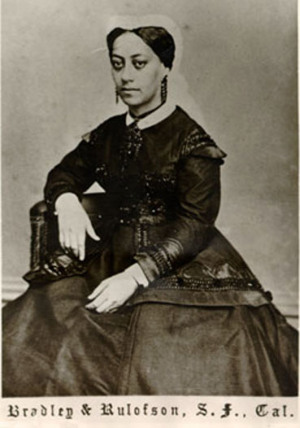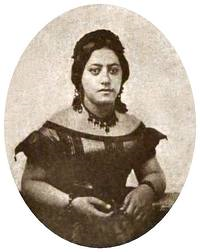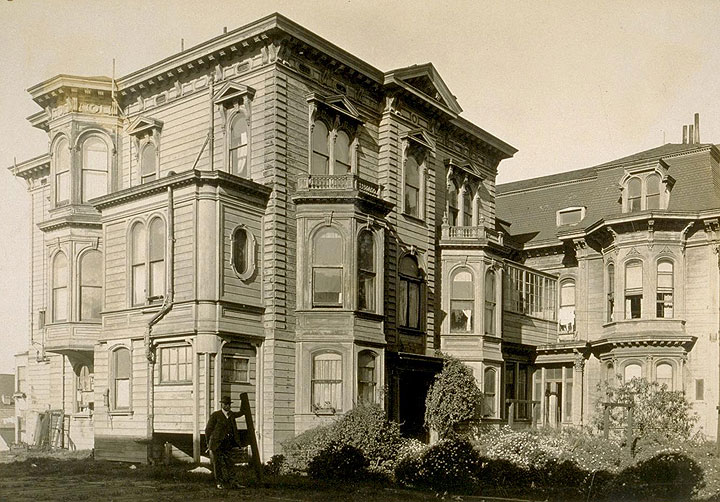
Good Morning POU!
How did a former slave who came to be known as the California Mother of Civil Rights amass millions in the mid 1800s??
Described as “a Rosa Parks, a Martin Luther King and a Malcolm X all rolled into one,” Mary Ellen Pleasant reportedly amassed some $30 million in real estate and investments with her *ahummm* partner Thomas Bell in San Francisco during the Gold Rush era.
Her partner huh? Oh where to begin.
This legendary woman of influence and political power in Gold Rush and Gilded Age San Francisco, was born, according to some sources, a slave in Georgia; other sources claim that her mother was a Louisiana slave and her father Native American. In one version of her memoirs dictated to her god-daughter, Charlotte Downs, she claimed she was born a slave to a Voodoo priestess and the youngest son of a Governor of Virginia, James Pleasants. In any case, she showed up in Massachusetts circa 1827 as a 10- to 13-year-old bonded servant to a storekeeper, “Grandma” Hussey. She worked out her bondage, then became a family member and lifelong friend to Grandma’s granddaughter Phoebe Hussey Gardner. The Husseys were deeply involved in the abolitionist movement, and Pleasant met many of the famous abolitionists.
Many sources agree that she lived in Boston, as a free woman passing for white. She married James W. Smith, a Cuban abolitionist, wealthy flour contractor and plantation owner who had freed his slaves and was also able to pass as white. When he died in 1844 he left her his estate, valued at approximately $45,000.
Mary Ellen next married and lived in New Orleans where she became close friends with voodoo priestess Marie Laveau. Her husband was said to have been a close relative of Laveau. She made her way to California, arriving in San Francisco in 1849. Her husband’s whereabouts after this time have never been made clear (he just sort of, disappeared). She started life in San Francisco as a cook for wealthy clients, then opened her own boardinghouse. Her guests were said to be men of influence, and it was rumored that her places were also houses of prostitution.
Many sources state that Pleasant was a very active abolitionist, helping escaped slaves find jobs around the city. When she heard of John Brown’s desire to incite slave rebellions, she supposedly met with him in Canada in 1858, handing him $30,000 of her own money to further his cause. When Brown’s attempt to seize the arsenal at Harpers Ferry failed, authorities began searching for her, though she was able to disguise herself and find her way back to San Francisco under the name of Mrs. Ellen Smith. When Brown was captured, he supposedly had a note in his pocket that said, “The ax is laid at the root of the tree. When the first blow is struck, there will be more money to help.” It was signed with the initials W. E. P., though some conjecture that Pleasant signed the note and deliberately made her “M” look like a “W.”
When Mary Ellen arrived back in San Francisco, she passed as white, using her first husband’s name among the whites, and took jobs running exclusive men’s eating establishments, starting with the Case and Heiser. During the 1860s she supposedly found wives for wealthy men as well as homes for their illegitimate children. She placed former slaves as servants in homes all over the city, creating a communication network for the receipt of gossip and information, in much the same way that her contemporary, the voodoo priestess MARIE LAVEAUX, built a power base in New Orleans. She met most of the founders of the city as she catered lavish meals, and she benefited from the tidbits of financial gossip and deals usually tossed around at the tables. She engaged a young clerk, Thomas Bell, at the Bank of California and they began to make money based on her tips and guidance and by 1875 they had amassed a 30 million dollar fortune between them.
Pleasant is best known for being the housekeeper (and rumored lover) for Thomas Bell, who married Teresa Percy, one of Pleasant’s protégés. By this time Pleasant was known to white San Franciscans as “Mammy,” and was said to have some sort of power over the Bells. It was even rumored that voodoo rituals were held in the Bell home on Octavia Street, and the mansion soon became known as the “House of Mystery.” Pleasant was considered a woman of mystery herself, and was described in newspaper articles and in the memoirs of native San Franciscans as “strange” “mesmeric” and “picturesque”.
After the Civil War, Pleasant publicly changed her racial designation in the City Directory from “White” to “Black”, causing a little stir among some whites. She began a series of court battles to fight laws prohibiting blacks from riding trolleys and other such abuses.
Pleasant continued to fight racism by suing a streetcar company for not allowing her to ride. She sued twice, once in 1866 and again in 1868. She finally received damages in the latter suit, but she had to have a white man witness the streetcar conductor refusing her a seat in order to win her case (which she did).
Pleasant was so influential in San Francisco, she was known as the “Black City Hall”.
In 1883 and 1884 Pleasant’s name was again in local newspapers because of her involvement in the court case of Sarah Althea Hill v. William Sharon. Sharon, a millionaire, former Nevada senator, and owner of the opulent Palace Hotel, was being sued by Hill for support under the terms of a secret marriage contract. The contract later proved to be a forgery and supposedly had been arranged by Pleasant. Pleasant’s access to and seeming power over the rich men of San Francisco made this a believable story to most of the city’s citizens. During the trial, Hill claimed to be “controlled” by Pleasant, and Pleasant’s appearance in court always caused a stir, as recorded on 6 May 1884 in the San Francisco Call: “Mammy Pleasant, as the plaintiff calls her colored companion, shows herself in court only as a bird of passage, so to say. She bustles in, converses pleasantly with the young men attached to the defendant’s counsel…and like a wind from the south astray in northern climes departs and leaves but chill behind.”
One of the few established facts in the life of Mary Ellen Pleasant is that Thomas Bell died in 1892, after a fall from the second story landing of the House of Mystery. Many thought Pleasant had murdered him; if so, and if the murder was for gain, it was fruitless, for when his wife inherited Bell’s money, she eventually forced Pleasant out of the house and into a small flat in the city’s African-American district.
Living in poverty, Pleasant was taken in by the Sherwood family, to whom she had rendered assistance at one time. When Pleasant died in San Francisco, she was placed in the Sherwood family plot in the Tucolay Cemetery in Napa, California. At her request, her gravestone contained the words: “She Was a Friend of John Brown.” After her death the San Francisco Call (12 Jan. 1904) reported a mysterious matter that pertained to her association with John Brown: “Among her effects are letters and documents bearing upon the historical event in which she played an important part. The Brown family raided her flat when Mrs. Sherwood took her home. After her death, the Sherwoods found Mrs. Pleasant’s trunks in her Webster Street flat to be all but empty.”
Pleasant seems to have wielded power over influential people, yet because she was African American and female, her activities did not reflect her racial and social status, which possibly led to the rumors that she engaged in voodoo and even murder. She moved freely through the highest levels of society, yet she dressed always like a servant. She left nothing in writing, and surviving diaries and newspaper articles paint her as a mysterious and sinister figure. At the same time, some recalled Pleasant as “generous,” claiming that she used her own money to aid African-American railroad strikers and assisted with other black causes. A few San Franciscans who were children during Pleasant’s lifetime remembered her as a churchgoing “lovely old lady” and said that they never believed the voodoo stories.




